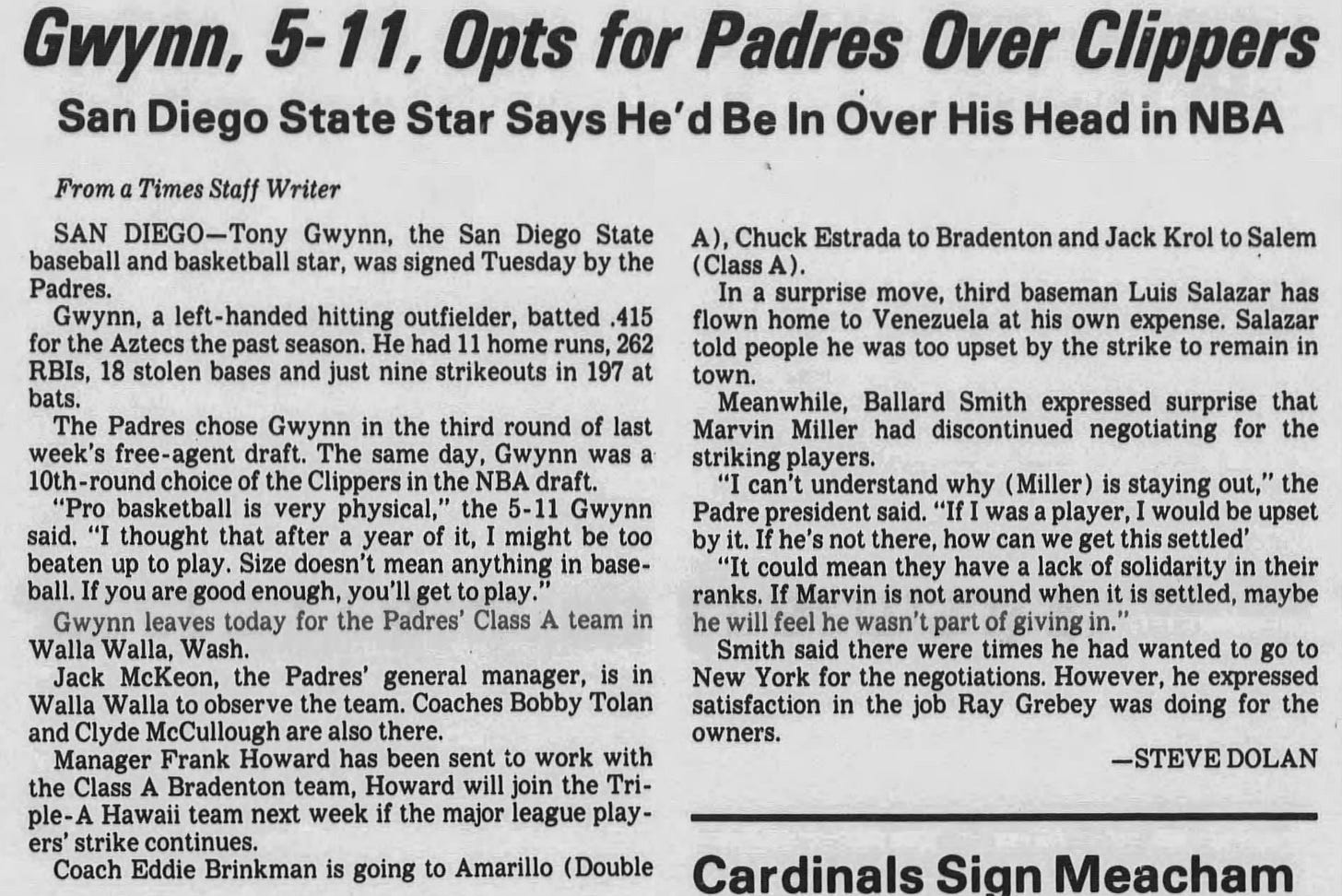Tony Gwynn: The Basketball Years
Today would have been the 63rd birthday of the late, great Tony Gwynn. Perhaps Major League Baseball’s greatest hitter since Ted Williams, and still the gold (or is that Silver1?) standard two decades after his retirement, Gwynn is THE face2 of San Diego sports.
Tony Gwynn’s status is owed primarily to his Hall of Fame career with the Padres, but Gwynn is one of the professional legends whose star began to rise at the college level in the same city.
And, a cornerstone of Gwynn’s legacy building from his time at San Diego State is the well-known bit of trivia that he was a multiple-sport athlete, playing point guard for the Aztecs basketball team as well as starring on the baseball diamond.
But beyond this just being a fun factoid that gets mentioned every once in a while, I wanted to see what I could discover about Gwynn’s hardwood exploits and share my findings with The Press Break audience.
Assorted multi-sport athletes were good enough to invoke discussions of their ceilings had they specialized in another sport: Randy Moss, whose high school basketball game gained national exposure in a Nike ad campaign at the turn of the millennium, may be the best example.
However, Moss himself downplayed his basketball potential in a conversation with Kevin Garnett a few years ago.
Predating Tony Gwynn, and in the same city, another Padres legend piqued the interest of scouts in both baseball and basketball. Dave Winfield played basketball at Minnesota, which as I note in my San Diego Union-Tribune feature from this past March, played a role in Arkansas basketball coach Eric Musselman’s diehard Padre fandom.
Winfield was good enough playing basketball in the Big Ten that the ABA had genuine interest. Did Gwynn have pro potential in hoops, too? He was, after all, a 1981 draftee of the San Diego Clippers; and while then-owner Donald Sterling was notorious for making decisions centered around short-term financial gain rather than building a winning basketball organization, one has to assume the athletically gifted Gwynn wasn’t taken as a publicity stunt.
So, let’s examine Gwynn the basketball player in more depth.
Sports-Reference is always a good place to start. Gwynn’s stats playing point guard for the Aztecs are solid: 9.7, 11.1 and 9.5 points per game over his final three seasons at San Diego State, but more impressive are his 5.9 and 6.3 assists per game in ‘79 and ‘81.
Distributing the ball effectively to teammates while keeping defenses honest with efficient scoring punch — as a senior, he shot 52.5 percent from the floor, an outstanding average for a perimeter player — are certainly desirable qualities for a traditional 1-guard.
Gwynn also averaged more than two steals per game as a sophomore, suggesting he was a tenacious on-ball defender — another attractive attribute from a point guard.
Stats can outline a picture, however, but without context are one-dimensional. I struggled to find conveniently accessible archival footage of Gwynn on the court, but I did come across this CBS 8 interview with Mr. Padre in his college days.
The next best thing when you can’t see for yourself are the testimonials of eye witnesses, so next I scoured Newspapers.com archives for firsthand accounts of Gwynn and San Diego State basketball.
SDSU moved into the Western Athletic Conference during Gwynn’s time as an Aztec, putting it in league with UTEP. The Miners were only a little more than a decade removed from winning the national championship, then as Texas Western and playing with an all-Black starting lineup as memorialized in the book (and later, shaky film adaptation) Glory Road.
Legendary coach Don Haskins devised a second-half comeback strategy in 1979 around keeping Gwynn out of the paint, a pretty clear indicator the Hall of Fame coach viewed the Hall of Fame right-fielder as the centerpiece of San Diego State’s offense.
The battles between the Aztecs and Haskins’ Miners included a wild back-and-forth in 1981 when Gwynn sank a 40-footer that would have sent the teams to overtime — had Gwynn’s shot been released before the buzzer sounded.
Gwynn went for 19 points that game, a team-high on a day that also saw one of the undisputed San Diego State basketball greats, Michael Cage, post a double-double of 17 points and 12 rebounds.
When Cage left SDSU, he was the program’s all-time career leader in both scoring and boards. When he arrived on Montezuma Mesa as a freshman, an upperclassmen saw potential in the big man: It was Tony Gwynn, a story Cage shared on the occasion of Gwynn’s birthday seven years.
Imagine an alternate reality in which Cage, who later played for the Clippers, shared the NBA courts with Gwynn. Perhaps it could have come to pass, though you can count Gwynn himself among those who just couldn’t see it panning out.
From a June 1981 edition of the Los Angeles Times:
Whether Gwynn, demonstrating the humility that was a defining trait of his remarkable MLB career, was actually too small for the NBA is debatable. He was drafted in the same NBA class as Isiah Thomas, for example, and was only about an inch or two shorter than the Indiana star-turned-Detroit Pistons legend.
“Tiny” Nate Archibald was still making All-Star Games at this point, too.
But given just three years after he was selected in both the MLB and NBA drafts, Gwynn was playing an integral role in the Padres advancing to their first-ever World Series, he obviously made the right choice.
One of my favorite sports posters — a dying artform worthy of its own in-depth examination — featured Gwynn, holding each of his Silver Slugger Awards, fanned out like wings, with the heading “Batman Forever.”
An argument can be made for Junior Seau, who graduated from Oceanside High School before heading to USC and returning to America’s Finest City as a member of the Chargers. I give the nod to Gwynn, however.





